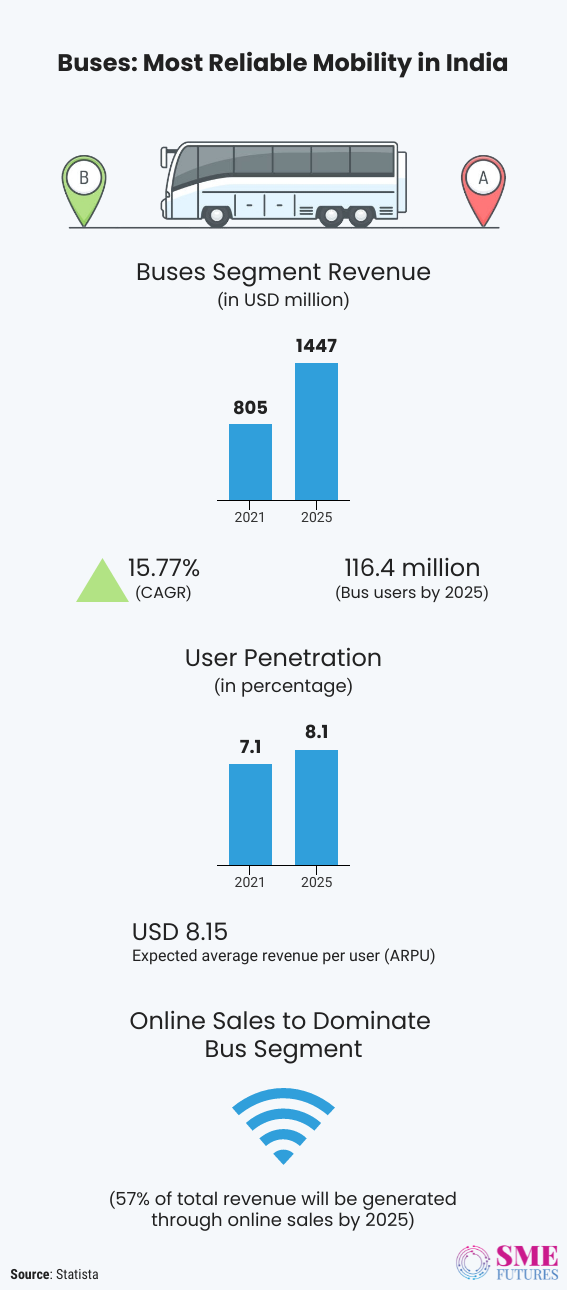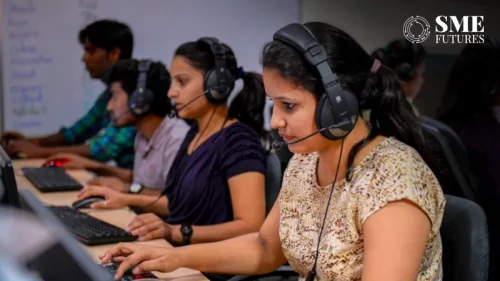Buses have always been the most popular mode of transportation in India throughout the history of its mobility. They offer affordable travel and access to livelihoods. The intercity bus market in India is estimated to be worth $15 billion and is growing faster than ever. According to figures, more than 400k buses are running on Indian roads, assisting over 15 million Indians daily to reach their destinations and providing livelihoods to millions of the unemployed in India.
At the same time, there is a lot of transformation happening in the arena of travel and the market associated with it and this fact applies to the various modes of travel as well. Nowadays, there is a lot more focus on changing urban mobility. Technology implementation and digital transformation is aiding this change.
Although the market is big, it’s highly fragmented. Thus, there are still many gaps that need to be filled. A mobility enthusiast, Amit Gupta, Co-founder and CEO at gogoBus, a Gurugram based travelling-as-a-service intercity bus platform is focussed on democratising the access to technology for fleet owners and customers in India.
The start-up assists fleet owners with its connected app-ecosystem coupled with real-time data insights to manage their daily operations seamlessly. Their solutions also help to maximize revenue while ensuring the right consumer experience. In a conversation with SME Futures, Amit Gupta talks about how the intercity market is changing due to the inception of technology and how the pandemic has accelerated this trend.
Edited Excerpts:
How is India’s intercity bus market shaping up with digital operations and the inception of new technology?
India is a bus country, where almost 50 per cent Indians travel by bus for a plethora of reasons. Yet, on the other hand, the Indian bus space is the most neglected part of our mobility system. The way our bus ecosystem works is still extremely traditional, and I believe that the mixing of technology is the only thing that can set intercity bus mobility in India apart.
The visibility, accessibility and ease that technology can bring is the need today. The chaos of this unorganised market is often addressed with the assistance of technology.
gogoBus is a transport-as-a-service (TaaS) based inter-city bus platform focusing on democratising the access of end-to-end technology to fleet owners while connecting consumers across India. We have a bunch of apps especially designed to empower each pillar of bus transportation. Once we are able to convince the traditional operators and agents to implement this technology into their daily operations, the face of bus service in India will change rapidly.
How has intercity bus travel changed post the COVID-19 pandemic?
COVID-19 has no doubt changed the way sectors and businesses work, and intercity travel is no exception.
In my observation as a player in this market, the pandemic has put a significant amount of pressure on intercity bus operators and the industry as a whole. Not only was there a drastic demand drop but it also remained at below par-level for an elongated period of 12-18 months. This led to a heavy financial burden on the operator-partners. Unfortunately, a few operator-partners have had to wind-up their erstwhile multi-generational businesses.
Although on one side a few operator-partners are pulling out of business, on the other side lots of new-age operator-partners have started accepting the importance of technology and data in planning their routes to maximise their revenue.
Along with that, bus-operator partners across India have become cognizant of the changing consumer requirements around safety and hygiene, wherein bus sanitization on every trip, a vaccinated crew and thermal screening have become the must-have criteria.
What are the various trends in this segment that you are seeing now that you could not have predicted a few years ago?
Data is the new age fuel, which now everyone understands. And interestingly, the COVID lockdowns have motivated bus operators even in the tier 2 & tier 3 markets to harness the potential of data by selecting the right route and right departure time slots to maximise every bus-trip’s earnings.
We at gogoBus are super excited to share that the real-time insights from our in-house data models help our bus operator-partners to minimise their time to reach break-even occupancy.

How did gogoBus perform during the crisis, and what is your current position in this market?
In the last 18 months of our existence, almost 50 per cent of it went home-bound due to the COVID-19 lockdown. We were working to solve the mobility challenges of our consumers. But COVID-19 struck us at a time when we had just started. So, for a start-up like us, no operations were not a part of any of our business scenario plans.
To be honest, it took us a while to figure out our way forward.
We went back to the drawing board to reassemble our learnings from the two months of our operations before the first lockdown. We then carved out our product-first strategy while re-aligning our app ecosystem. Which resulted in the creation of a total of six apps, which cover everyone from the consumer to the driver to the agents. Here is an overview of our app conglomerate.
We have an app called the gogoBus app for consumers. They can easily search and book on the gogoBus app. And it’s available on the Android & IOS app stores. Then there is an app called the Swami App. This app is dedicated for operators and helps them to manage all their consumer booking and boarding and profit and loss (P&L) on a real-time basis.
We have also designed an app for drivers called the Sarthi App. This app is for the contactless boarding of passengers. It keeps in check any type of unauthorised boarding and is a great platform for live route tracking. Another exclusive app is for agents—Sathi App, which is designed specifically for digitising offline bookings. Our helpers or attendants use the Mitr App to manage consumer grievances. Last but not least, the Sanchalak App is an admin app for a top-level view of the overall daily operations. These apps have made our operations easier.
At the same time, I believe that the future belongs to connected mobility, and this is what we intend to do—build a connected bus mobility ecosystem within one platform. gogoBus is going to be a brand that everyone can trust. And our slogan is—Think Mobility! Think gogoBus!!
What’s your current presence, and how is the brand growing now?
As mentioned earlier, we founded this start-up in January’2020 and since then our journey has been nothing less than thrilling. I recall starting with a single passenger, who travelled from Kanpur to New Delhi and in less than three months, we were running buses with 100 per cent occupancy. However, the pandemic outbreak did put a break for a while on this growth.
Interestingly, COVID has only helped us in a positive way to re-align our product-first go-to-market strategy while building connectivity for Bharat. During this period, we also did one strategic acquisition in Jharkhand, a blue ocean territory.
Post the lock-down relaxation, we commenced our operations in the eastern part of the country. We were growing at a healthy pace on a month-on-month basis, when the second wave brought a temporary halt to our services again.
Since we resumed our services in July’2021, we are growing at a 100 per cent month-on-month basis. Besides that, as of now we have crossed over 3,000 consumer trips with 14 lakhs+ kms of distance covered. And at this pace we are targeting to reach 100+ cities in the next 3-5 months.
Currently, we are present in the eastern, northern and central parts of the country. We have expansion plans in the pipeline. Very soon we will be in the western and southern parts of the country, while expanding our reach across India.
There are far too many players, both old and new, in the intercity bus travel arena. Explain the competition in this space, as everyone is embracing new-age solutions in some way.
The gogoBus platform is built on a smart and intelligent route engine, which suggests the best route based on demographics, alternate connectivity options and frequency.
We strongly believe in co-opetition and with our unique platform approach, we are working with each and every stakeholder to solve the problem of information asymmetry at scale. So, in my opinion, the more new age players we have, the better it will be for the bus mobility industry, and this would eventually lead to a better consumer experience.
In a nutshell, the whole idea behind building gogoBus, is to build a TAAS (Transportation as a Service) platform for bus mobility in India.
How does sustainability come into play in the intercity bus market? What are the practices you have adopted in this regard?
A large portion of the Indian populace travels via public transport, particularly by buses and that too on a daily basis. However, it’s also one of the sources for the carbon emissions that are harmful for our environment. According to an OECD analysis, if our mobility systems do not change, then transport CO2 emissions could increase by 60 per cent globally by 2050.
Thus, it’s more imperative than ever to adopt sustainable urban mobility solutions.
And to contribute towards a sustainable future, gogoBus is planning to introduce a fleet of electric buses. We are in advanced talks with a few OEMs for the same.
Along with this as a future plan, as of now we are providing contactless and paperless onboarding and ticketing and digital luggage tagging. These are some of the key features that we are using to increase sustainability in this sector.
In your opinion what are the challenges that the fleet operators are still facing?
I believe, one of the few challenges that the fleet operators in India are facing today is around adapting to the latest technology. Most of the operators find the cost immoderate, thus getting access to a seamless tech-system becomes difficult for them. At the same time, limited digitisation in the ecosystem surrounding fleet owners is often not ready or at par. Then there is also the reluctance to adopt the changes. In addition to this, the lack of tech savvy or trained people also indicates a gap in this market.
Apart from this, COVID-19 has also brought many challenges for fleet owners mainly related to the financial losses incurred by them, their crew and fleet management and their payments towards loans.
How do you see the new-age bus companies and the start-up landscape going ahead and how will the opportunities change?
New age tech start-ups are here to make a difference. But even before this, digital transformation and adoption of digital services was making a huge difference.
With more than 500 million smartphone users, more than 700 million internet users and increased digitalisation, I believe bus mobility on Indian roads is on the verge of a new revolution. With this, the intercity bus market in India will see phenomenal growth in this space in the next decade to come.
Tell us about gogoBus’s roadmap down the line, what’s the next big thing for the brand?
We are thoroughly working to change the face of bus mobility in India, and this is what we plan to do. In the next 5 years, we want to have a connected and transparent system across the country. Our aim is to have 5000+ buses with a 20 per cent EV fleet on our platform in the next five years. And this also involves our sustainability goal.
Currently, to achieve our targets, we are working on multiple advanced tech features, which we also want to implement in our fleets. These features consist of an AI-based passenger counting system, a route optimisation system and a connected mobility system. These new solutions would be implemented to enhance and ensure our consumer’s safety and security.











